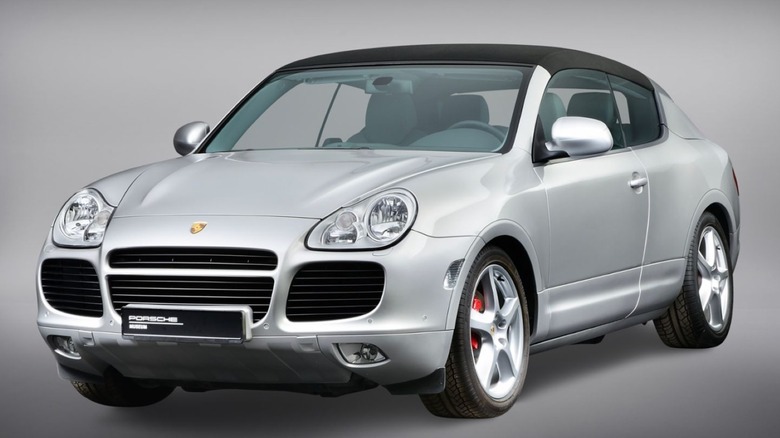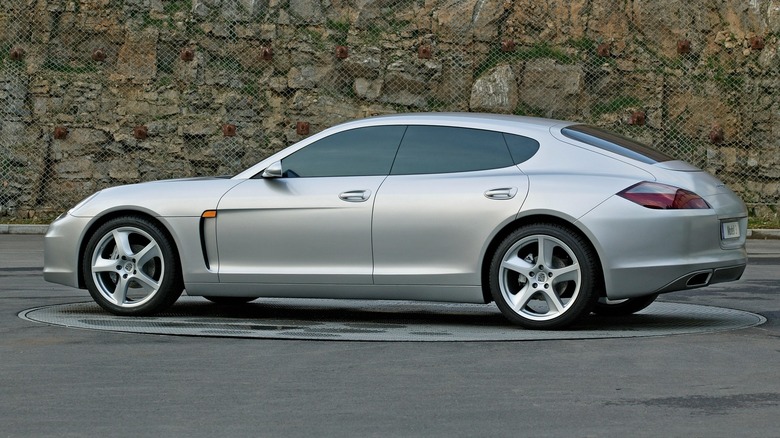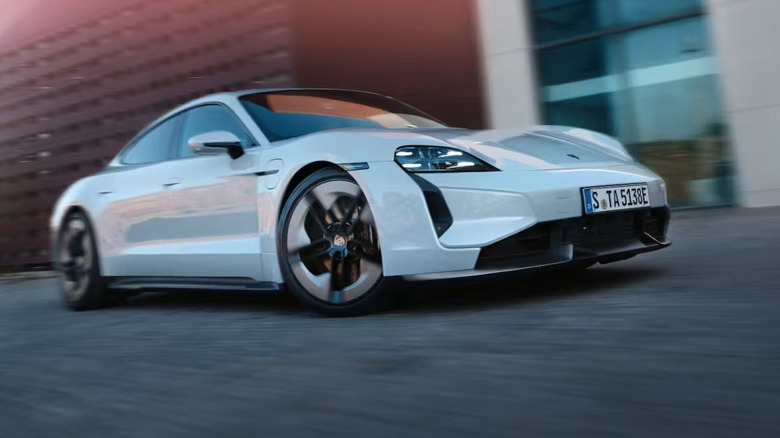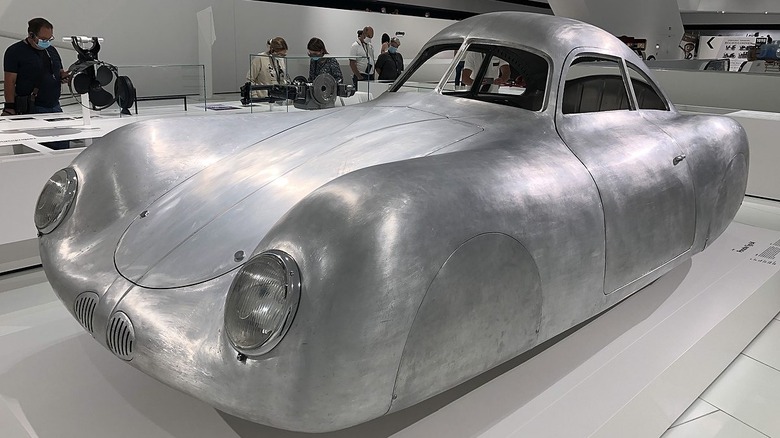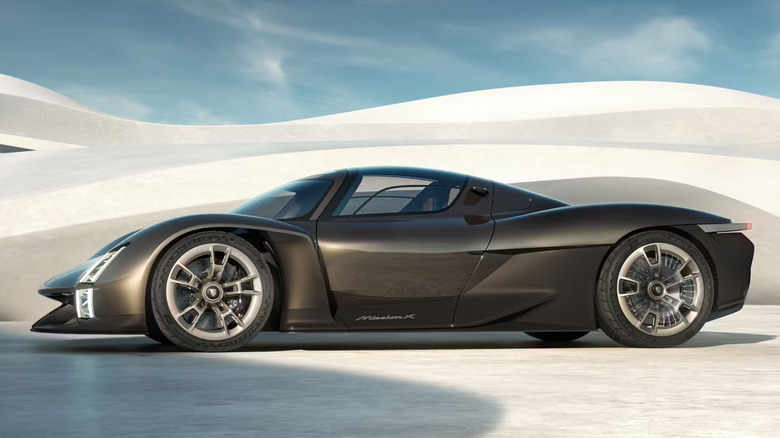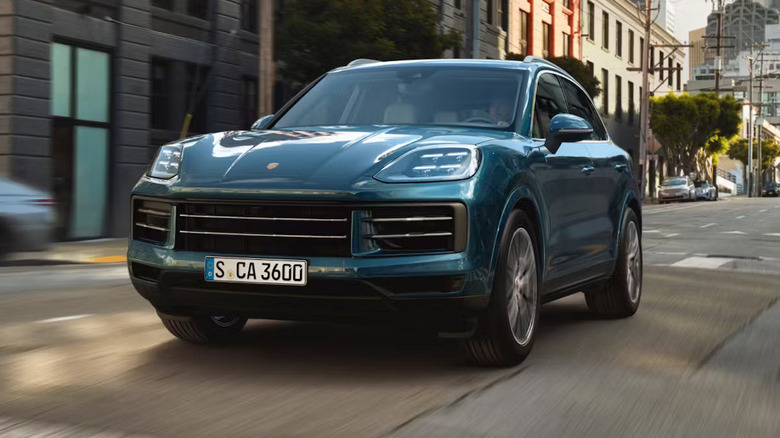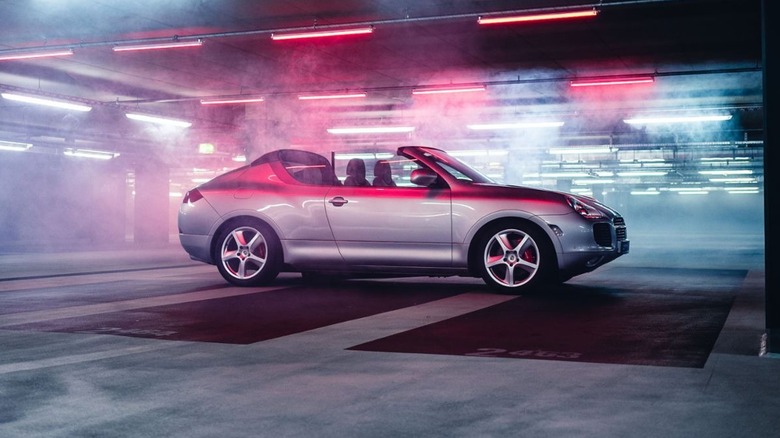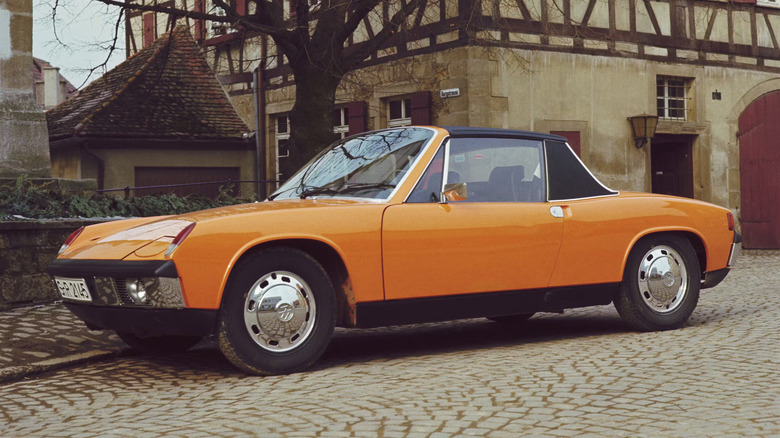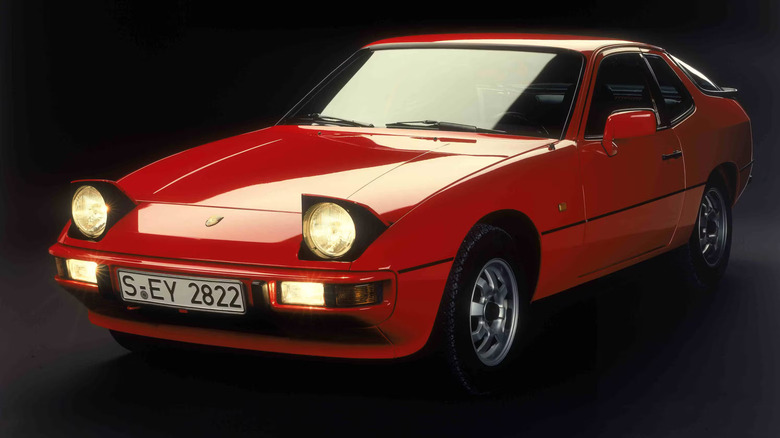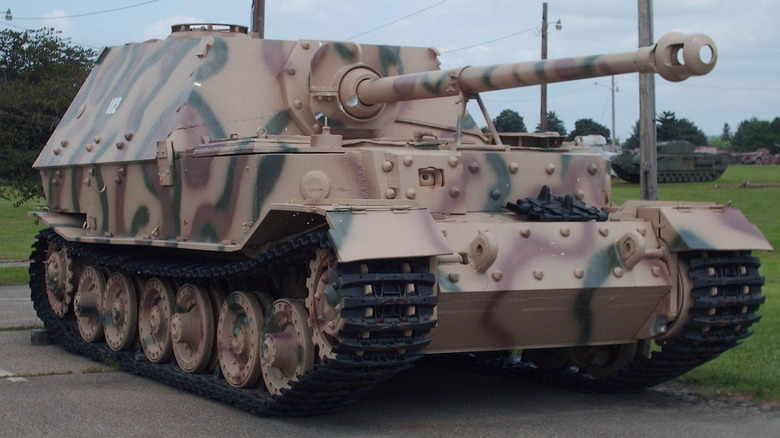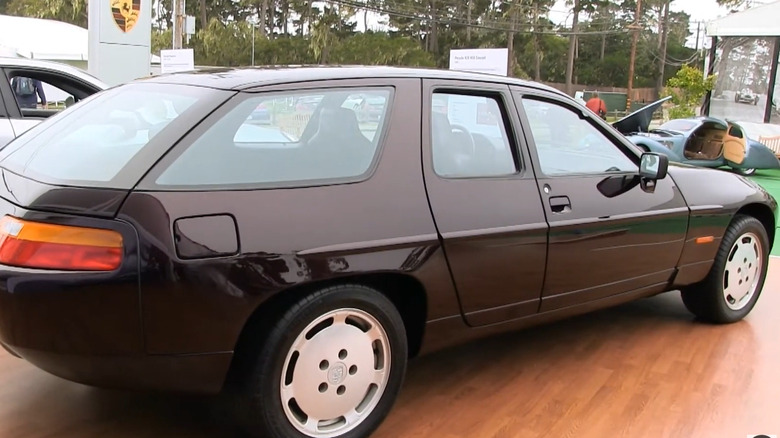10 Of The Worst-Looking Porsches Ever Made
Porsche is one of the most successful and long-running brands in the history of sports cars. The iconic car company has spent generations pushing the limits of speed and design with vehicles that are suited to both the slick asphalt of a racetrack and a daily commute to the office. They've long been on the cutting edge of automobile aesthetics and have produced some of the coolest-looking cars ever made, from the perennial Porsche 911 to the classic Porsche 550, a favorite of screen legend James Dean, who infamously met his tragic end behind the wheel of one such vehicle.
However, even the greatest designers make mistakes. Not every Porsche is a timeless testament to German engineering. Some are actually quite ugly, especially when they try to steer Porsche away from its strengths as a two-door, two-seat vehicle made for going fast on the highway. With that in mind, here are our picks for 10 of the worst-looking Porsches ever made.
Porsche Panamera Mirage Concept
With the Panamera, Porsche sought to combine the sleek aesthetics of a sports car with the roomy sensibilities of a sedan. In theory, the Panamera has been successful, having sold over 235,000 units in its first 10 years, well over Porsche's initial estimate of 200,000 cars.
In practice, however, a four-door Porsche just looks ... off. Take, for instance, the Mirage, one of the concept cars that ultimately led to the Panamera's final design. It's bizarrely long, but still small, like a Dachshund, more commonly known as a wiener dog. The core problem, and something that will become a running theme in this list, is that if you try to combine a luxury sports car with another type of vehicle, then you lose what made it a sports car in the first place. This looks more like a station wagon on steroids than a proper sports car, and the lumbering hot dog looks like it would jarringly jut out of any reasonably sized parking space.
2024 Porsche Taycan Turbo S
Porsche's electric alternative to the Panamera is the Taycan. Pictured here is the 2024 Turbo S model, which also boasts a four-door design that just never looks right to our eyes. Still, we have to admit, if we absolutely had to get a four-door Porsche, it would probably be a Taycan. That being said, this vehicle suffers from the same issue as all the rest of Porsche's four-door lines, which is that the back half just feels unreasonably huge and unwieldy.
Sports cars are supposed to be small and sleek, but the Taycan, despite its stylized lines and aerodynamic contours, is big and bulky. From a distance, it looks like a sports car, but up close, that appearance is a lie. The Porsche Taycan is like an overweight person trying to look thin by wearing black clothes with vertical stripes and sucking in their gut, but they're trying way too hard, which isn't precisely the look you want for a $200,000+ sport(y) car.
Porsche 64
No, this isn't a long-lost Nintendo 64 game. In fact, car historians argue whether or not the Porsche 64 is even really a Porsche, since it predates the Porsche branding by nearly a decade. The car's body was incredibly light, allowing it to reach its top speed, 88 MPH, with great efficiency. It was to be entered into a 1939 race from Berlin to Rome, a 940-mile test of speed and endurance, but the outbreak of World War II put an end to those plans, and Ferdinand Porsche shifted his focus from racing cars to designing tanks for the Nazi war machine (but more on that later).
While ostensibly being the first Porsche gives the 64 enormous historical value, it's worth noting that this thing is ugly. Not to sound like an insult comic, but it looks like a dangerously emaciated Volkswagen Beetle. Actually, that isn't an inaccurate description of the car, since it used an engine and other mechanical parts from the VW 38, a prototype vehicle that would eventually become the Beetle.
Porsche Mission X Prototype
The 2023 Mission X is a concept car showing the potential for the future of Porsche hypercars. Based on this vehicle, the future is Porsche trying to look like a Lamborghini knockoff. Seriously, this thing, while pretty in its own way, is visibly unrecognizable as a Porsche. It looks more like a UFO. The driver's seat is supposed to look like an airplane's cockpit, but with the glass dome-style roof, both driver and passenger can get sunburned like ants under a magnifying glass.
Perhaps in a nod to aerodynamics, the Mission X doesn't have traditional side mirrors. In fact, it doesn't have any side mirrors at all. Instead, it has computer screens inside the car that simulate the visuals of a side mirror, called digital wing mirrors. Call us old-fashioned, but cars need mirrors. Real mirrors. They're an essential part of safe driving, and we don't want to trade them in for computer screens. Even if the computer screens are extremely low-latency, they'll never be as low-latency as actual mirrors!
Porsche Cayenne Turbo
Some people want a Porsche, but they also want a big, fat (and reliable) SUV. We don't know any of those people, but the Porsche Cayenne Turbo is the car for them. What can we say? It's an SUV. Curiously, there's a coupe version of the car, which is nearly as ugly, but at least gets to maintain the illusion of some of the traditional Porsche sporty sensibilities. The SUV, on the other hand ... well, it's an SUV. There's nothing anyone can do to make an SUV look cool, much less the level of cool that Porsche is supposed to represent.
The Porsche Cayenne Turbo was featured in the 2003 video game "007: Everything or Nothing," in which Pierce Brosnan's James Bond drove a version of the car outfitted with Q enhancements like machine guns and rocket launchers to take down bad guys while speeding through levels set in Egypt and Peru. However, that still didn't stop millions of young video game enthusiasts from wondering why James Bond was driving a car for soccer moms.
Porsche Cayenne Convertible Concept
Remember when we said there's nothing that can be done to make an SUV look cool? Well, Porsche tried, and the result was this monstrosity, a concept car that, thankfully, never made it to production. The concept, pun intended, is simple: Make a Cayenne into a convertible. However, the result is bulky, bizarre, and ugly. Family-sized cars are simply not meant to be convertibles. Come to think of it, maybe family-sized cars are not meant to be Porsches at all.
If Porsche had been able to pull off such a ridiculous concept as a convertible SUV, they wouldn't have just stopped there. Had this thing gone to the assembly line, who knows what else Porsche would have done? Perhaps hockey rinks would be cleaned by Porsche Zambonis, we'd all be going to work in Porsche city buses, and our trash would be left outside to be picked up by Porsche garbage trucks! Thank goodness that future never came to pass, or this list would have a lot more than just 10 entries.
Porsche 914
They say you can't beat a classic, and in some ways, the Porsche 914 is the quintessential Porsche. It's small, sporty, but not too extravagant, with room for groceries in the trunk. It's not just a mid-life crisis status symbol, but a real car that you might find in any town or city in the world. But while other Porsches on this list try too hard, maybe the Porsche 914 isn't trying hard enough. This car might as well just be named the Porsche Car, for how plain and unassuming it is.
The 914 debuted in 1970, at the tail end of one of the coolest eras in the history of automobiles. The 1960s were the era of James Bond's Aston Martin DB5, Adam West's Batmobile, and the Green Hornet's Black Beauty. It was the era of Elvis Presley playing race car drivers in three different movies between 1964 and 1968 (the movies, for those interested, were Viva Las Vegas, Spinout, and Speedway). In response to this era of legendary and iconic cars, all Porsche could muster was the 914. The Porsche 914 was a perfectly fine vehicle on its own merits, to be sure, but when stacked up against these legendary contemporaries, it is downright homely by comparison.
Porsche 924
Porsche's follow-up to the 914 didn't fare much better from an aesthetic standpoint. While the 914 was a humble offering that was overshadowed by its peers, it retains something of a timeless, if unassuming, profile. On the other hand, the Porsche 924 suffers from being the Porsche of the 1970s. After the expressionistic vehicles of the 1950s and 1960s, cars became a lot more utilitarian in the 1970s, aiming for efficiency over aesthetics, which were usually saved for extras like wood paneling (why was there so much wood paneling in the '70s?)
The Porsche 924 looks like the entire decade rolled into one car, from the dopey headlights to the overall compact form factor. As a result, it looks terribly dated. Whereas the 914 looks vintage, the Porsche 924 simply looks old, an unfortunate side effect of catering to the trends of the time rather than carving out its own path.
Porsche Ferdinand/Elefant Tank
Most German companies that were around in the late 1930s have an unfortunate period in their history, and Porsche is no different. During World War II, company founder Ferdinand Porsche, a card-carrying member of the Nazi Party, designed a tank destroyer for the German war effort.
Initially named the Ferdinand, after himself, the vehicle was nicknamed the Elefant ("elephant"), presumably due to its long trunk, in the form of an 88 mm gun. Due to the size of the cannon, the tank was not equipped with a rotating turret. As a result, the Elefant was more powerful, but less versatile than a full battle tank. At close range, it was nearly defenseless on its own, and as such, was best used from a distance, as mobile artillery. However, they put Elefants on the front lines, leading the charge into enemy territory, where they were at a tactical disadvantage. As a result, of the 91 units produced, only two survived the war. One was captured by the Soviets, and the other by American forces.
The Ferdinand tank destroyer wasn't exactly a looker. Essentially, it was a giant gun glued on top of the treads of a cancelled prototype. It wasn't pretty, but it was a giant mobile gun, and that's all it needed to be. The Elefant was a tremendously dangerous weapon, and had the Nazis been smarter about its usage, World War II could have been even longer and bloodier than it ultimately was.
Porsche 928 H50 prototype
Aesthetically, Porsche's biggest mistake was trying to turn a sports car into something it wasn't. The origins of that folly can be found with the Porsche 928 H50 prototype, a concept car from the 1980s that asked the question: What if the Porsche 911, one of the most beautiful cars ever made, was ugly? It's a question we didn't need answered, but the engineers at Porsche did it anyway. The H50 prototype features a four-door design and an uncomfortably large booty, resulting in a vehicle that feels like two cars taped together.
Ultimately, the Porsche 928 didn't go for this look, and instead became one of Porsche's more visually pleasing vehicles of the 1980s. However, one can tell from just a glance that a lot of DNA from the prototype made it into what would eventually become the Panamera, as seen at the top of this list. If there's a lesson to be learned from all this, it's that if you buy a Porsche, don't get one with more than two doors ... or a Nazi tank. For the most part, if you keep those two rules in mind, you should be fine with the (mostly) lovely vehicles produced by Porsche.
